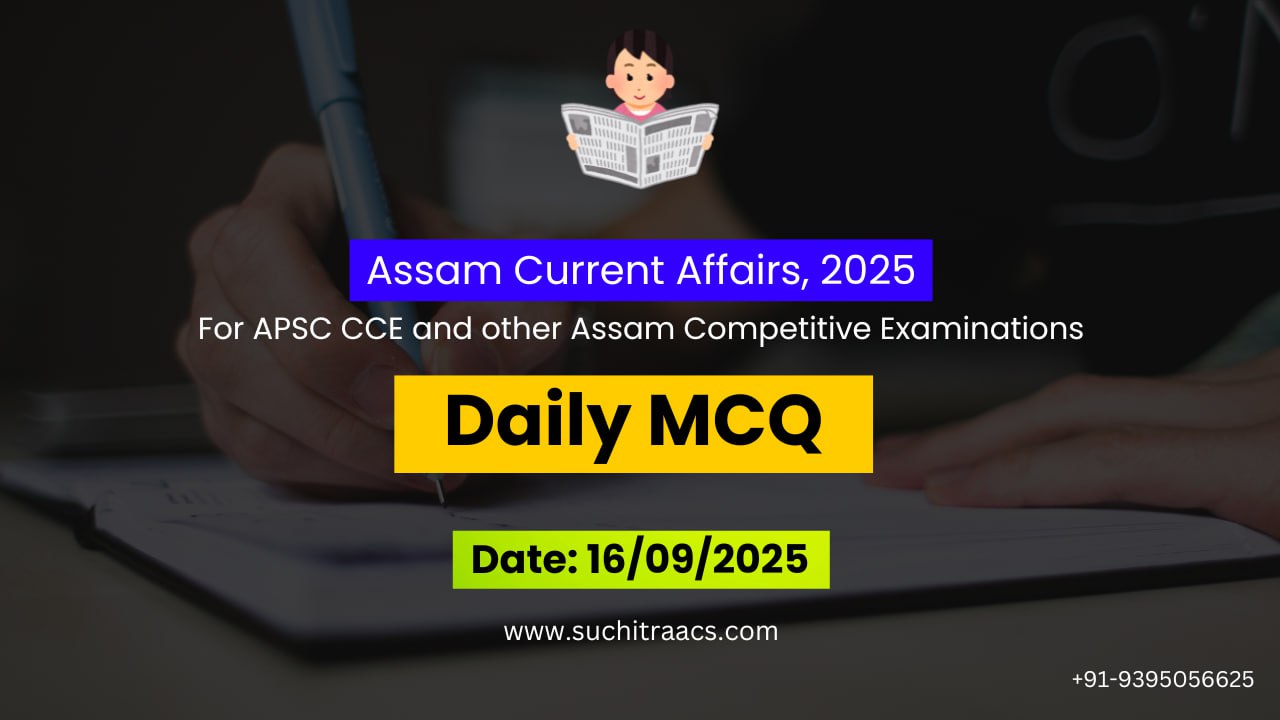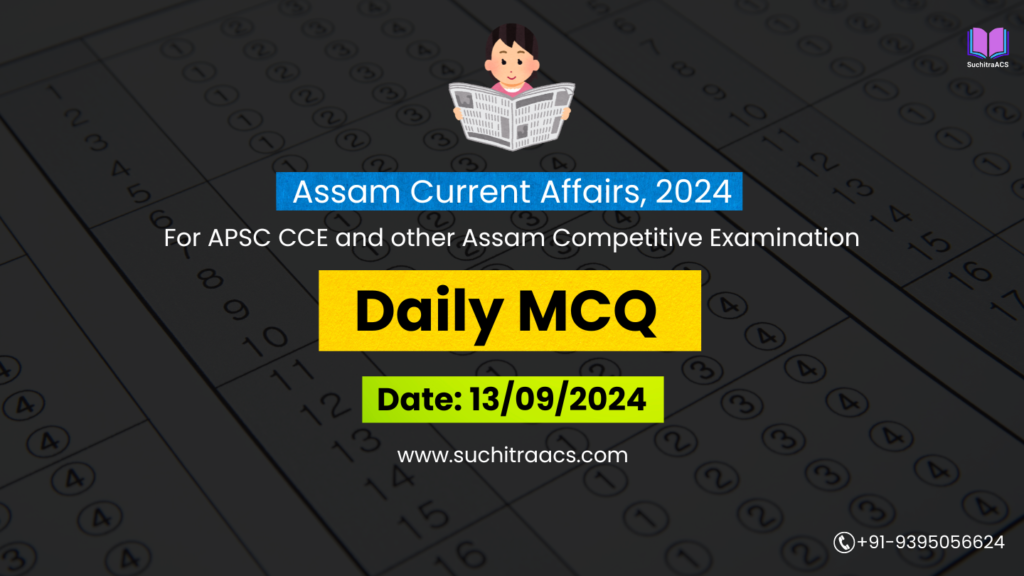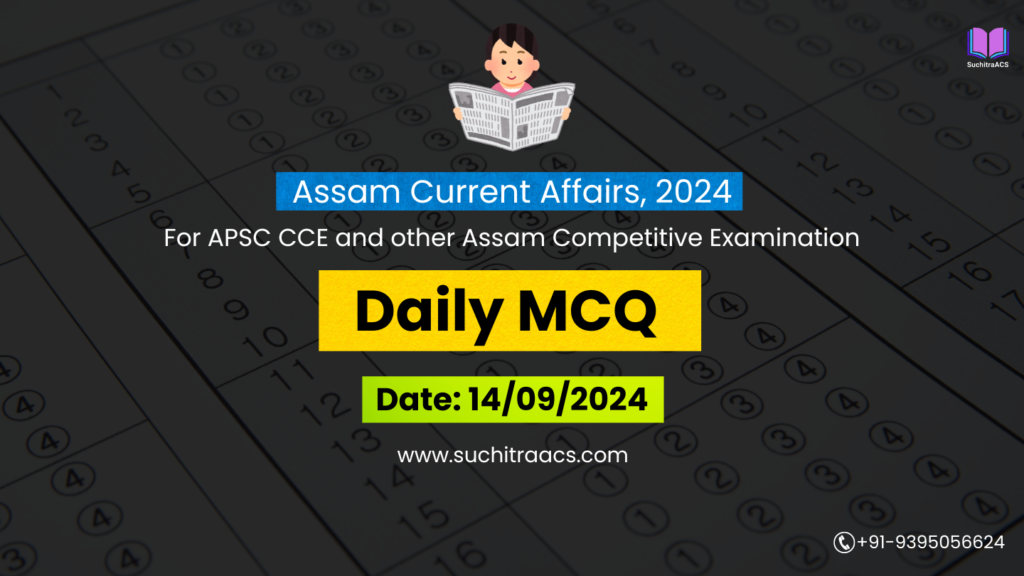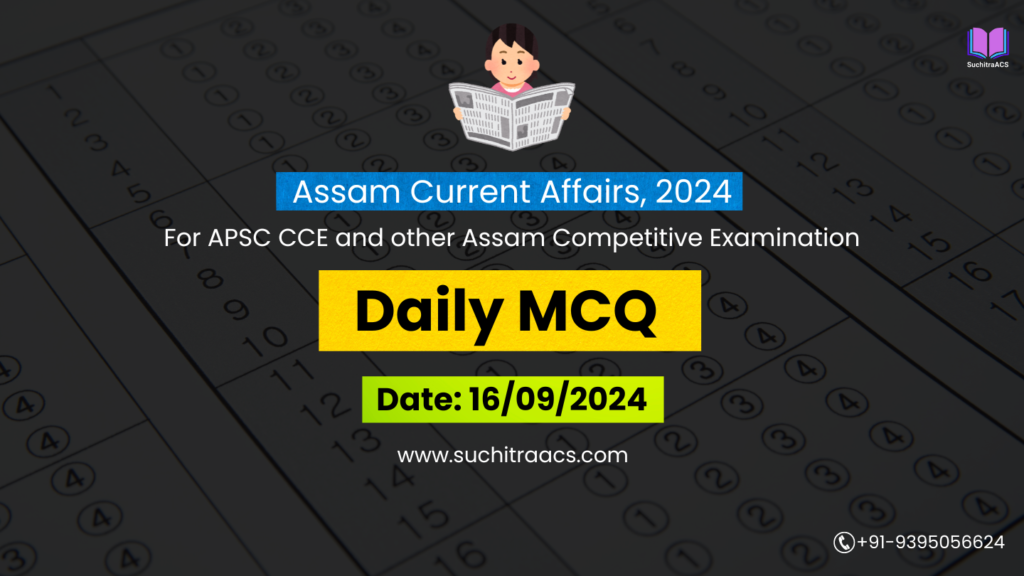APSC MCQs / APSC Prelims Practice Questions based on Assam Tribune (Daily) –16/09/2025
For APSC CCE and other Assam Competitive examinations aspirants, practicing Daily MCQs is vital. This blog covers most important Prelims questions from the Assam Tribune today (16-09-2025). These issues are key for both APSC Prelims syllabus, offering insights into the important topics of current affairs.
✨ APSC CCE Online Coaching, 2026

APSC MCQs / APSC Prelims Practice Questions (Date: 16/09/2025)
1. Guwahati Metro Rail Project (Assam–Japan MoU)
Q1. Which of the following cities in India had the first operational Metro Rail system?
a) Delhi
b) Bengaluru
c) Kolkata
d) Mumbai
👉 Answer: (c) Kolkata
Explanation: Kolkata Metro began in 1984; Delhi Metro started in 2002.
Q2. The Japan International Cooperation Agency (JICA), often in news for funding metro and infrastructure projects in India, is:
a) A UN body for infrastructure financing
b) A Japanese government agency for development cooperation
c) A private consortium of Japanese banks
d) A regional agency under ASEAN
👉 Answer: (b)
2. Revival of Nagaon & Cachar Paper Mills (HPC units)
Q3. With reference to Hindustan Paper Corporation (HPC), consider the following statements:
- It was a PSU under the Ministry of Heavy Industries.
- Its Nagaon and Cachar Paper Mills were closed in 2017 and 2015 respectively.
- The primary raw material for these mills was bamboo.
Which of the statements are correct?
a) 1 and 2 only
b) 2 and 3 only
c) 1 and 3 only
d) 1, 2 and 3
👉 Answer: (d)
Q4. Assam contributes around what percentage of India’s bamboo resources, making it vital for paper and pulp industry?
a) ~10%
b) ~25%
c) ~40%
d) ~60%
👉 Answer: (d)
Explanation: Northeast India accounts for ~66% of India’s bamboo stock; Assam is the largest contributor.
3. Floods in Dhemaji & Lakhimpur (embankment breaches)
Q5. Consider the following rivers:
- Subansiri
- Jiadhol
- Sankosh
- Gainadi
Which of the above are tributaries of the Brahmaputra affecting Dhemaji & Lakhimpur floods?
a) 1, 2 and 4 only
b) 1 and 3 only
c) 2 and 4 only
d) 1, 2, 3 and 4
👉 Answer: (a)
Explanation: Subansiri, Jiadhol, and Gainadi affect Dhemaji–Lakhimpur. Sankosh flows into western Assam near Bhutan.
Q6. Which of the following statements about Assam’s flood vulnerability is correct?
a) About 40% of Assam’s land is flood-prone, compared to 12% of India’s land area.
b) Embankments in Assam were built mainly after the 1897 earthquake.
c) The Brahmaputra carries one of the lowest sediment loads in the world.
d) Assam has less flood-prone land compared to Bihar and UP.
👉 Answer: (a)
Explanation: Assam’s flood-prone land = ~40% of its area (India average = 12%). Embankments began post-1950s floods. Brahmaputra has one of the highest sediment loads globally.
4. India–Bhutan Border Talks (security & trade)
Q7. Which Indian states share borders with Bhutan?
- Sikkim
- Assam
- Arunachal Pradesh
- Meghalaya
- West Bengal
a) 1, 2, 3 and 5 only
b) 1, 2, 4 and 5 only
c) 2, 3 and 5 only
d) 1, 2, 3, 4 and 5
👉 Answer: (a)
Explanation: Bhutan shares borders with Sikkim, Assam, Arunachal Pradesh, West Bengal. Not with Meghalaya.
Q8. Operation All Clear (2003), conducted by Bhutan, was aimed at:
a) Evicting illegal timber smugglers from Bhutan’s forests
b) Removing Indian insurgent camps (ULFA, NDFB, KLO) from its soil
c) Clearing border haats for trade facilitation with India
d) Resettling Bhutanese refugees in Assam
👉 Answer: (b)
Mixed/Analytical
Q9. Which of the following best explains the importance of border haats along the India–Bhutan and India–Bangladesh borders?
a) They are meant for export of bulk goods.
b) They provide duty-free trade in agricultural & local products for border communities.
c) They are exclusive to India–Bhutan border.
d) They are managed by the UNDP.
👉 Answer: (b)
Q10. Why is the India–Bhutan border considered strategically stable compared to India’s other neighbours?
a) Bhutan has no trade relations with China.
b) Bhutan relies heavily on India for hydropower, trade, and security cooperation.
c) Bhutan’s border is militarized under a UN peacekeeping mission.
d) The India–Bhutan Treaty (1949) forbids Bhutan from engaging with third countries.
👉 Answer: (b)
Explanation: Bhutan enjoys close ties with India (hydropower, defence, economy). Treaty of 2007 allows Bhutan independent foreign policy while retaining special ties with India.
Explanation: Barak flows through Mizoram, Manipur, and Assam before entering Bangladesh; not Nagaland.
✨ APSC CCE Courses, 2025-26 offered by SuchitraACS


🔔 Join Our WhatsApp Study Group!
For exclusive access to premium quality content, including study materials, current affairs, MCQs, and model answers for APSC CCE and other Assam competitive exams.
Click here to join: SuchitraACS Study WhatsApp Group
📚 Want to know more about SuchitraACS’s most affordable courses?
Click here to know more: SuchitraACS Courses for APSC CCE and Assam Competitive Examinations




